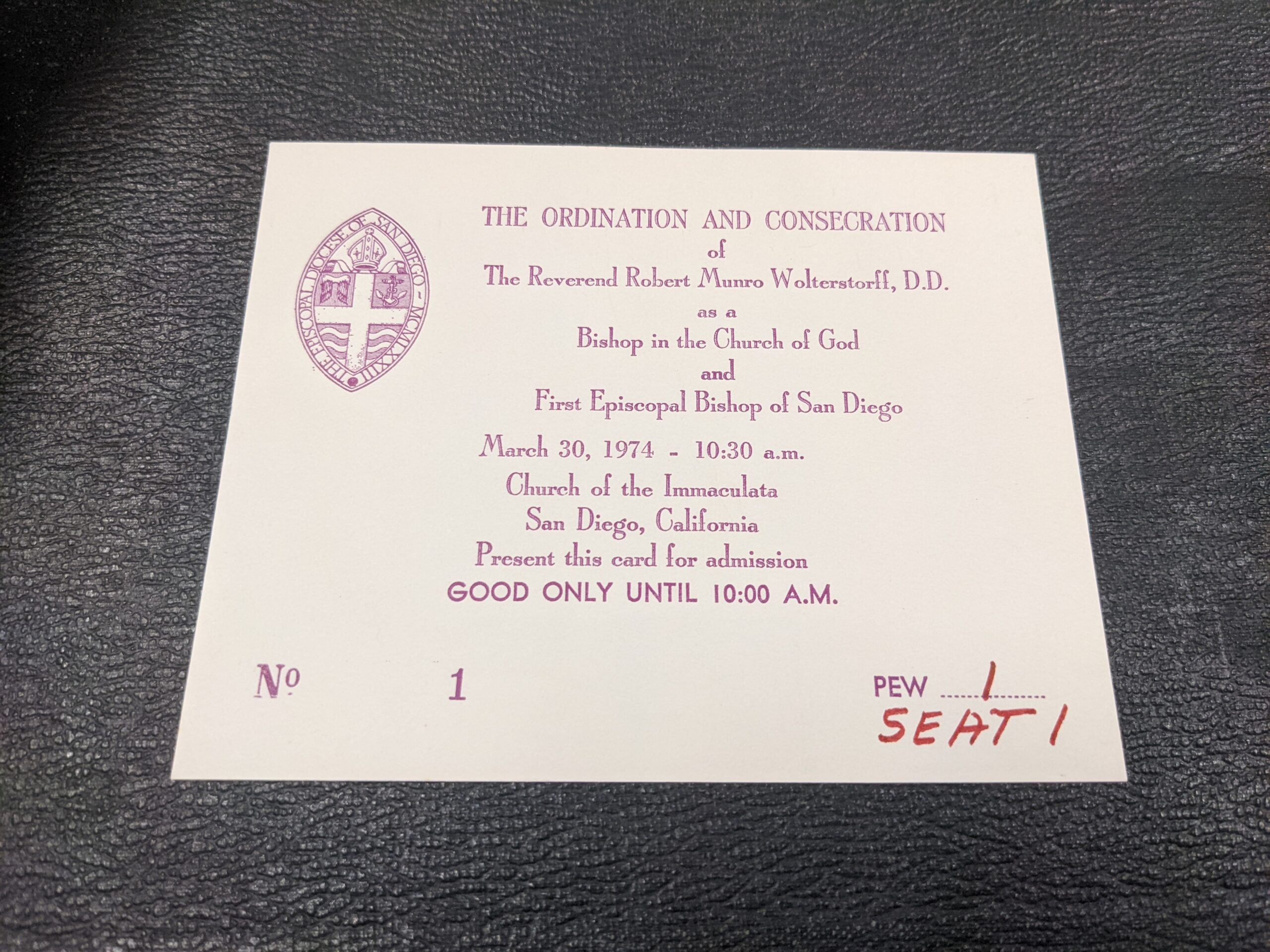Our History: With a New Diocese Came a New Leader

In recognition of the Episcopal Diocese of San Diego’s 50th anniversary this year, we are posting a series of articles exploring our history. In the photo above, the newly consecrated Bishop Wolterstorff greets the congregation with the Peace.
Beneath the shadow of San Diego palm trees, a religious transformation was taking root in the early 1970s; a new chapter began for Episcopalians throughout San Diego, Imperial, and Riverside counties. A portion of the Episcopal Diocese of Los Angeles was carved out, paving the way for a new diocese–The Episcopal Diocese of San Diego. And with a new diocese came a new leader.
Bishop Robert M. Wolterstorff was a stalwart figure with a past deeply intertwined with the region. Having served two decades as the rector and associate rector at St. James by-the-Sea in La Jolla, he wasn’t new to the San Diego community. When he was consecrated as the first bishop of the freshly minted Episcopal Diocese of San Diego on March 30, 1974, anticipation buzzed in the air.
wasn’t new to the San Diego community. When he was consecrated as the first bishop of the freshly minted Episcopal Diocese of San Diego on March 30, 1974, anticipation buzzed in the air.
Bishop Wolterstorff said, “People call me bishop, but it’s hard to realize they’re actually talking to me. It’s a new experience that’s going to take some getting used to.”
The day before the consecration, Sunday, Bishop Wolterstorff and his family worshiped at St. James in La Jolla. He said, “We sat in a pew just like everybody else, something we haven’t done very much as a family down through the years.”
In a city as varied and vibrant as San Diego, Episcopalians were a growing family, with 39 distinct congregations and 20,000 members. Bishop Wolterstorff recognized the diversity and richness of the diocese’s tapestry. Bishop Wolterstorff pondered aloud to a San Diego Union newspaper reporter that he intends “to knit us into a family.”
Many in the community remember Bishop Wolterstorff’s beaming optimism. Susan Mallory, a bank president who had the privilege of knowing him since 1957, fondly reminisced about him as “a unifier.” To her, the blend of his unwavering faith, values, and optimism made him an inspiration.
However, the journey was full of challenges. The winds of change were blowing across the broader Episcopal community. In 1976, a significant shift occurred as the church voted to ordain women as priests. While many embraced this change, Bishop Wolterstorff held onto his traditional beliefs. Two years after his retirement, the diocese ordained Patricia Bush, the first female priest in the Diocese of San Diego.
Be yond his ecclesiastical life, Bishop Wolterstorff had a passion for education. The Bishop’s School in La Jolla witnessed his influential hand. Under his trusteeship, the school transformed from an all-girls boarding institution into a coeducational daytime campus.
yond his ecclesiastical life, Bishop Wolterstorff had a passion for education. The Bishop’s School in La Jolla witnessed his influential hand. Under his trusteeship, the school transformed from an all-girls boarding institution into a coeducational daytime campus.
As we trace Bishop Wolterstorff’s journey back to his early days, we find a young man born in 1914 in St. Paul, Minnesota. The call of the divine led him to St. Ambrose College in Davenport, Iowa, and later to the Seabury-Western Theological Seminary in Evanston, Illinois. The 1940s saw him ordained, first as a deacon and then as a priest, marking the commencement of a life devoted to faith.
When the news of his passing at 92 reached the community, it came with a heavy heart. But in the silent corridors of the churches he served and in the hallowed grounds of the institutions he touched, Bishop Robert M. Wolterstorff’s legacy lives on–a testament to a life lived in faith, ministry, and an unwavering love for this community.